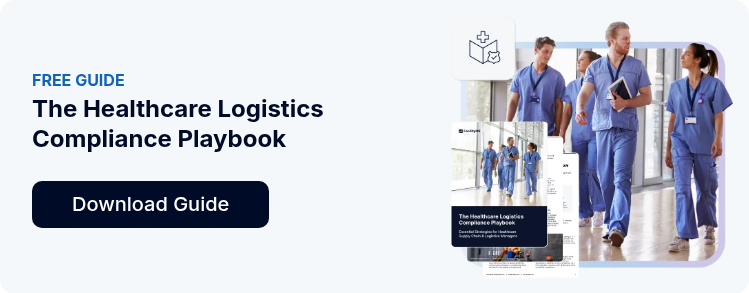Beyond the Dock: Why the Last Yard is the Key to Solving Logistics Waste
In modern logistics operations, significant innovation and investment have been directed towards resolving last mile challenges associated with delivering goods from the facility’s distribution center to its final destination. However, optimizing the last mile often leaves a critical gap for many organizations, particularly in healthcare and pharmaceuticals: what occurs after the shipment arrives at the dock.
This final stage, the movement of goods from the receiving dock to the precise point of use, is called the last yard. Frequently overlooked, this phase can harbor inefficiencies, delays, and errors that undermine the gains made upstream.
Increasingly, forward-thinking facilities recognize that the last yard is more than just a logistical afterthought. It presents a strategic opportunity to enhance efficiency, improve team performance, and achieve better outcomes. To fully grasp its significance, it is helpful to consider how the last yard complements and completes the journey that begins with the last mile.
The Missing Link: From Last Mile to Last Yard
Last mile delivery has become a key component of modern supply chain strategy, providing speed and visibility up to the facility's arrival point. However, once a shipment reaches a receiving dock, that visibility often ends. Many organizations lose track of materials once they enter the building, relying on manual processes to complete internal deliveries or ERP systems that can only capture limited chain of custody events or information.
These internal blind spots can lead to delays, misrouted goods, and wasted labor, diminishing the efficiency of the most effective upstream supply chains. Without a structured process for managing internal deliveries, the facility's overall performance suffers.
In contrast, a strong focus on the last yard ensures that materials arrive on time, are delivered accurately to their intended locations within the facility itself and include necessary proof of delivery. Digital tools, such as FacilityOS’s asset and logistics management solution, LogisticsOS, help bridge this gap. By mapping and monitoring internal workflows, LogisticsOS helps ensure that every step, from the dock to the point of use, is accounted for.
Last yard plays an important role in completing the supply chain journey, but how does it generate value for facilities?
Why the Last Yard Requires Attention
Optimizing the last yard generates value for facilities as it helps reduce inefficiencies and unlocks measurable benefits throughout the organization.
First and foremost, optimizing the last yard provides end-to-end visibility. Facilities that extend visibility beyond the dock can monitor deliveries in real-time, tracking them by department and room. This level of oversight enables proactive decision-making and enhances accountability. Solutions like LogisticsOS, facilitate this with intuitive tracking tools, keeping teams informed and aligned.
Improved visibility also speeds up internal workflows. These internal workflows become predictable and efficient for routing, reducing bottlenecks, eliminating unnecessary handling, and ensuring staff can rely on timely material deliveries. As a result, teams can focus on higher-value responsibilities instead of tracking down missing items or waiting for delayed deliveries.
Beyond efficiency, optimizing the last yard boosts workforce productivity and morale. When employees can depend on reliable internal logistics, they perform more effectively, allowing the organization to operate at its full potential.
Lastly, optimizing the last yard helps maintain accuracy and compliance in industries where precision is crucial. Misplaced or mishandled materials can be costly and risky, particularly in regulated environments. Digital tracking mitigates these risks by maintaining a clear chain of custody, which is especially important for healthcare and pharmaceutical facilities.
The Value of Last-Yard Optimization in Healthcare and Pharmaceuticals
The impact of poor internal logistics is especially significant in healthcare and pharmaceutical settings. These industries operate under strict timelines and rigorous regulatory oversight, making even minor disruptions potentially harmful to patient care, product integrity, or compliance.
Time and temperature-sensitive materials, such as vaccines, biologics, and other controlled substances, require careful handling and timely delivery to their point of use. Additionally, facilities must adhere to regulatory demands from agencies like the FDA and standards organizations like the Joint Commission, which require verifiable internal traceability of materials.
In this type of environment, last-yard delivery is more than just a convenience; it is necessary. Digital solutions, like LogisticsOS, assist healthcare and pharmaceutical facilities in meeting these high standards by offering comprehensive visibility, maintaining controlled environments, and generating auditable records of internal movements.
With high stakes, how can facilities begin implementing more effective last-yard strategies?
Practical Strategies for Improving Last-Yard Delivery
Improving last-yard performance requires a strategic approach that combines technology, process enhancement, and team alignment. These practical strategies include:
- Digitizing Internal Logistics: Implement software to track and manage internal deliveries, transitioning from manual to more reliable and efficient processes. Technology like LogisticsOS can seamlessly integrate with existing supply chain systems.
- Establishing Clear Processes and Training: Develop standardized workflows for internal deliveries and ensure that all staff members are adequately trained on those procedures and expectations.
- Collaborating with External Carriers: Work closely with external carriers to facilitate smooth handoffs at the dock. Logistics software enables you to capture item details, catch discrepancies, and start your digital chain of custody so you can maintain visibility throughout the delivery process.
- Utilizing Real-Time Monitoring and Notifications: Set up dashboards and alerts to inform staff about delivery status, enabling prompt action and accountability. LogisticsOS provides configurable dashboards tailored to your facility's needs.
By implementing these strategies, organizations can fully realize the benefits of last-yard optimization.
Benefits of Last-Yard Optimization
Facilities that optimize the last yard can achieve significant, measurable improvements. Reducing operational waste and costs enhances internal workflows, making them faster and more reliable. As a result, employees experience less frustration and higher productivity, leading to better patient and customer outcomes.
Facilities that utilize solutions like LogisticsOS report increased compliance readiness and more consistent service quality, which are essential differentiators in highly regulated or competitive industries.
Moving Forward: Elevating Internal Logistics
Focusing solely on the last mile is no longer enough for organizations aiming for operational excellence. The last yard is a crucial part of the supply chain that directly impacts efficiency, compliance, and service delivery.
Organizations that excel in this final stage are better positioned to achieve improved performance, reduced risk, and greater value for customers and stakeholders.
To enhance your internal logistics, begin by reviewing your existing workflows and considering purpose-built last-yard solutions like LogisticsOS, engineered for the unique challenges of your facility.
Stay updated with industry insights, success stories, and more by following us on social media for the latest FacilityOS content.
Table of Contents
Jesse Rosenbaum




 Follow us on Facebook
Follow us on Facebook  Follow us on X
Follow us on X
 Follow us on LinkedIn
Follow us on LinkedIn